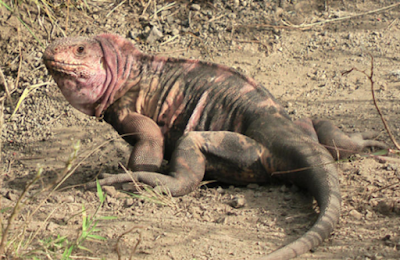The Instituto Geofísico-Escuela Politécnica Nacional has reported an eruption on Wolf Volcano, on Isabela Island in the Galápagos Archipelago, late on Thursday 6 January 2022. The eruption produced an ash column about 3800 m high as well as a number of lava flows on the flanks of the volcano. The volcano lies at the northern end of the island, 100 km from the nearest settlement, and is not considered a threat to Human life, although eight people working close to the volcano at the time of the eruption, including park rangers and a group of scientists studying the Critically Endangered Pink Land Iguana, Conolophus marthae, were evacuated as a precaution.
Wolf Volcano is the highest volcano in the Galapagos, reaching 1707 m above sea level, with an oval crater measuring 6 km by 7 km orientated in a northwest-southeast direction. Like all the volcanos of the Galapagos it is a shield volcano, i.e. a volcano made up largely of overlapping lava deposits that resembles an upturned bowl rather than a cone. The placement of this volcano on the northern tip of Isabella Island creates a unique microhabitat on the northwestern flanks of the volcano, cut off from the rest of the island by the steep, smooth lava flows of the main peak. This has served to protect the wildlife of the volcano from invasive species such as feral Cats and Goats, which threaten much of the unique fauna of the Galapagos (though Goats have recently been sighted here). As well as the Pink Land Iguana and its own unique Tortoise, the Wolf Volcano ecosystem is also home to several populations of introduced tortoises from other islands.
The volcanos of the Galapagos are fuelled by a mantle plume, the Galapagos Hotspot, an upwelling of hot magma from deep within the Earth’s mantle which pierces the overlying Nazca Plate, and moves independently of it. This plume transverses the plate at a rate of 0.46 degrees per million years, which has led to the formation of the string of volcanoes which form the Galapagos Islands. However, analysis of the geochemical composition of the lavas of Wolf Volcano has shown that these are distinct from the lavas of the neighbouring Ecuador and Darwin volcanoes, but show strong similarities to lavas produced on the Galapagos Spreading Centre over 200 km to the north, a trait shared with lavas from other Galapagos volcanoes, most notably Santa Cruz and Genovesa, suggesting that there is some interplay between these two sources.
Wolf Volcano is the most active volcano in the Galapagos, it was first observed erupting in 1797 and most recently in 2015; the 2022 eruption is the twelfth recorded eruption on the volcano, which is believed to be slightly less than 500 000 years old, compared to an age of about 10 million years for the surrounding seafloor. It takes its name from Theodor Wolf, a German geologist who made the first organized study of the volcanoes of the Galapagos in the nineteenth century, and after whom Wolf Island is also named.
See also...


Follow Sciency Thoughts on Facebook.
Follow Sciency Thoughts on Twitter.






